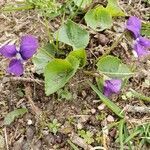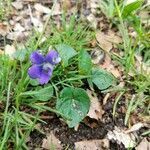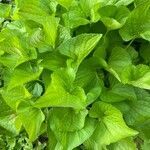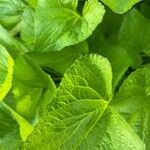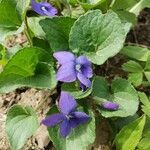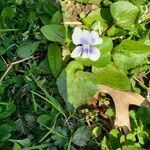Glabrous to often evidently spreading-hairy, acaulescent; rhizome short, stout, oblique or horizontal, sometimes branching to form colonies; lvs all merely crenate-serrate, cordate at base, the blade typically held at an angle to the strongly ascending petiole, ovate to orbicular or reniform, acute to often obtuse or rounded above, the summer-lvs to 13 cm wide; fls seldom elevated much above the lvs, 2–3 cm wide, relatively broad and open, appearing flat-faced; pet relatively wide, deep violet to lavender or white, the 2 lateral ones densely bearded with relatively long hairs (many of them ca 1 mm or more) that are only slightly or not at all expanded upwards; spurred pet glabrous or sometimes bearded, nearly or fully as long as the lateral ones; cleistogamous fls stout, on horizontal to erect peduncles; fr thickly ellipsoid, evidently surpassing the sep; seeds dark brown; 2n=54. Moist or wet places, sometimes in disturbed sites and somewhat weedy; Nf. and Que. to B.C., s. to Fla., Tex., and Calif. Apr.–June. (V. affinis, a form with the spurred pet bearded; V. papilionacea, a subglabrous form; V. priceana, the Confederate violet, with pale gray-blue fls and a conspicuous violet eye; V. novae-angliae, a form transitional to no. 3 [Viola sagittata Aiton]; V. floridana; V. langloisii; V. latiuscula; V. missouriensis; V. pratincola; V. septentrionalis)
More
A perennial plant. It grows 10-15 cm high and 15-20 cm wide. It does not have a stem. It has underground stems or rhizomes. The leaves are scalloped and thick. They are 10 cm long. The leaves are hairy underneath. The flowers are violet-blue or white with streaks and speckles. They have short spurs.
Moist meadows, low woods and shady banks, often on sandy substrates. Dry to mesic habitats in woods, thickets, stream banks, moist prairies, pastures, disturbed ground, not in saturated soil; at elevations up to 3,000 metres.
More
It is a temperate plant. It is frost hardy. It suits hardiness zones 4-9.
Can be grown by divisions or seedlings. Seeds needs stratification.
